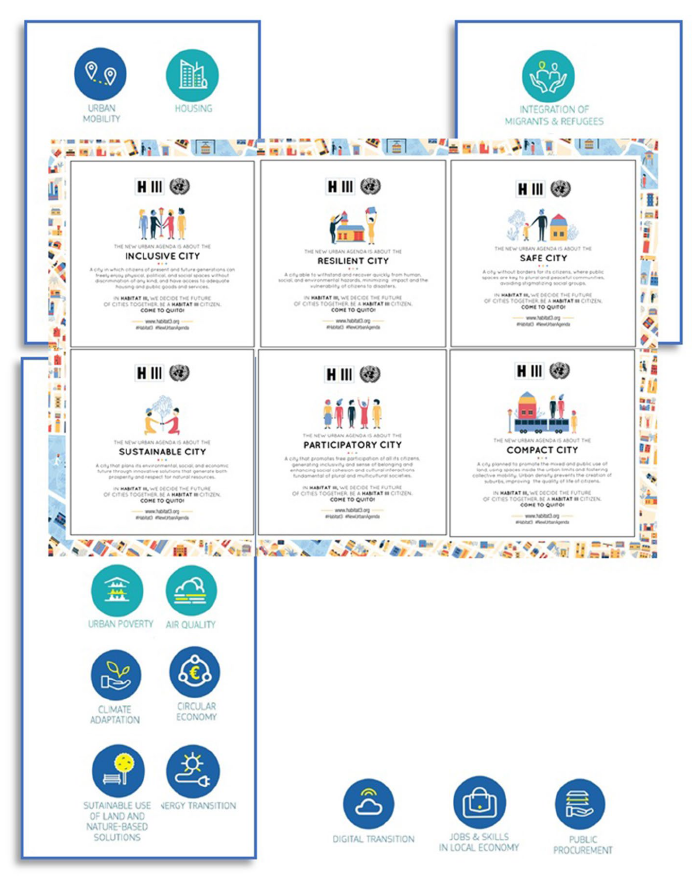
Researcher Maria Luisa Marsal Llacuna published an article on the Journal of Environment, Development and Sustainability, regarding the implementation of sustainable urban agendas. The article provides an a-up to date review on this issue. Here there are some of the key issues.
United Nations-Habitat New Urban Agenda and European Union’s Urban Agenda are today’s international Agendas safeguarding sustainability of our cities and communities. Both share the same vision for balanced, sustainable and integrated urban development.

Although in different ways, these Agendas incorporate “smart” concepts and therefore acknowledge the important role that technology plays, especially in both delivery and implementation. However, although the incorporation of the technological element, Agenda’s sustainable policies have poor adoption, and this is due to the lack of executive instruments to help their implementation.
The main reason for this poor uptake and implementation of both instruments and agendas is the high data requirements to feed indicators and indices, putting off poorly resourced potential receivers. And this, inevitably, results in poor implementation and uptake.
Another major problem with international instruments and Agendas is the commonly too much top-down delivery process, with poor societal engagement which ends in poor uptake by the final end user, the citizen. This top-down approach also contributes to a misrepresentation of actual human needs which will result in a failed implementation as citizens’ requirements will not be properly identified
The fact that both urban Agendas do not include indicators or indices and that they are already designed as bottom-up programs poses a big challenge because this means that some sort of new metrics will need to be created and an ever more bottom-up functioning needs to be factored in.
The Author’s response to this challenge has been the creation of the Policies–Actuated–Planning (PAP) executive function, an empowering technologically enabled bottom-up execution of policies contained in urban Agendas, and the Actuators. The article stress that the Planning Actuated Policies on their own are not sufficient. To enable effective delivery of the policies a novel system of design values and qualitative metrics are also needed. The researcher calls these Actuators—a vital ingredient in the quest to making useful change happen.
The PAP function is a truly bottom-up mechanism, allowing community participation at the lowest possible level, thus committing to serve the challenge of strengthening the bottom-up delivery proposed by both urban Agendas. On the other hand, the nature of Actuators, as digitally enabled urban planning design values, serve the second challenge of providing urban Agendas with a measurement system that allows for the qualitative measurement of performance in the implementation of policies through the technologically enabled urban planning interventions; in other words, the Actuators measure the performance of the PAP. The author highlights that differently from Actuators leveraging on the Internet-of-Things (IoT) to activate urban devices, the Actuators proposed here activate urban planning interventions by enhancing its execution at the lowest possible community level.

In order to design the Actuators, a comprehensive State-of-the-Art (SotA) study of IoT in relation to the technologies enabling and facilitating the urban planning practice has been conducted to identify what are the current developments and what can be used or should be further developed to create the Actuators and their enabling Policies–Actuated Planning (PAP) functionality. Therefore, to build an understanding of the SotA, the IoT has been researched in combination with urban planning practice technologies, which are the following, arranged from bigger to smaller scope functionalities:
GIS, Geographical Information Systems
UIS -or UPIS-, Urban (Planning) Information Systems
BIM, Building Information Modelling
GIS are software solutions with mapping and indexing functionalities of items mapped. Once properties have been added to items, a database is formed, and these can be searched, clustered and investigated.
The IoT offers new possibilities to GIS thanks to its real-time collection of data. Moreover, IoT combined with Big Data and GIS will allow the processing and real time dissemination of data from IoT deployed at a geographical scale.
Differently from GIS, UIS or Urban Planning Information Systems (UPIs), inform about urban assets having an actual location but not necessarily being geographical bodies. Therefore, UIS and UPIS will use some GIS elements. For instance, an UIS is typically used to map public services and infrastructure in the city and to index the life cycle of these assets, including maintenance contracts, operational staff. A UPIS will contain the zoning details of a city’s master plan where the delimitation of zoning areas has a geographical boundary but not a physical body.
GIS and UIS/UPIS cover the urban scale and operate at city dimension. BIM is used at building level. Current research experiments on IoT and BIM combined aim at increasing interoperability and coordination between IoT and BIM systems so that performance and management of construction processes can be improved.
Conclusions
According to the working hypothesis, the Actuators are able to execute urban planning interventions implementing policies. Moreover, Actuators, due to their technological nature, will allow for measurement and performance accountability. Similar to existing technologies operating in the urban domain, Actuators will be IoT supported to sense urban planning actions to be executed. Moreover, Actuators will be integrated in both GIS and UPIS systems to locate urban planning interventions being executed. Finally, interaction with the built environment will be sought through BIM systems to monitor the qualitative performance of physical executions implementing policies.
In short, the article stresses how important is to emphasize the community-based nature of PAPs and Actuators so that they can be used at the lowest possible level, believing that higher granularity of PAPs and Actuators will make them easier to implement since their policies and associated planning actions will require less effort and resources. Moreover, the sense of community ownership of policies and planning actions is important in terms of implementation and uptake because it reduces dependence on the administration. Therefore, the main purpose of this research was to create executive instruments—PAPs and Actuators—to succeed in implementing policies and planning, and that would especially serve communities, which is where there is less presence of administrations and smart technologies to ensure implementation.